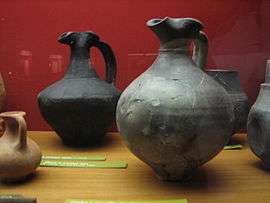Flagon

A flagon (/ˈflæɡən/) is a large leather, metal, glass or ceramic vessel, used for drink, whether this be water, ale, or another liquid. A flagon is typically of about 2 imperial pints (1.1 l) in volume, and it has either a handle (when strictly it is a jug), or (more usually) one[1] or two[2] rings at the neck. Sometimes the neck has a large flange at the top rather than rings.[3] The neck itself may or may not be formed into one, two or three spouts. The name comes from the same origin as the word "flask".[4]
Usage
The purpose of the rings is that you put your first (or first two) fingers into these or, if no rings, under the flange, or, if no flange, your hand into the handle, palm upwards, you rotate your forearm both up and away, turning your wrist so as to rest the flagon on top of your crooked elbow raised nearly to the horizontal, and you can then turn your head and drink straight from the flagon by pulling down with your fingers and lifting your elbow. Where there are two or three spouts, this caters for right-hand or left-hand use, and means the head does not need to be turned so far. The weight of the flagon is taken by the upper arm, and the control (by flexing shoulder and fingers) is very fine. The flagon was developed for a specific purpose: to take liquid refreshment (usually cider) out into the fields to sustain the agricultural laborers or perhaps, in Roman times, to refresh the rowers aboard ships.
Christian use
As a Roman Catholic term or use, the flagon is the large vessel, usually glass and metal, that holds the wine. Before March 2002, a flagon may have also been used to hold the wine during the consecration of the Eucharist and then be poured into many chalices. This pouring of the precious blood from flagon to chalice was eliminated. A smaller container called a cruet is used for the priest's chalice, usually identical to the cruet of water, which is mingled with the wine before consecration. The cruets do not remain on the altar after the preparation of the gifts.
In the Anglican Church, the flagon is the vessel that contains the wine to be consecrated. If more than one chalice is used during the administration of Communion, the flagon (or an additional cruet filled with wine and water) is placed on the altar at the Offertory, and other chalices are brought to the altar after the Breaking of the Bread. There should be only one chalice on the altar during the Great Thanksgiving.
New Zealand
In New Zealand, a flagon refers to a glass vessel filled with beer available in public bars or bottle stores. Drinkers could take their own washed flagons or swap their empties for those pre-filled, corked and ready for sale. The flagon was followed by the half-gallon (2.27 l) jar and was preceded by the square rigger and the bluey. These were commonly used during the period of six-o'clock closing of bars. A flagon can hold different volumes of beer or wine and is thought to have originated from an amendment to the licensing laws, which took effect in 1881. The amendment allowed winemakers to sell wine from their vineyards for off-licence consumption, so long as the quantity was 2 gallons (9 liters) or more (hence the "2 g" flagon). Before this change winemakers could only sell wine from hotels. A half-gallon flagon was a common volume used for beer.
Ireland
In modern Ireland a flagon usually refers to a two-litre bottle of cider, or in some cases a 350ml bottle of spirits.
References
- ↑ "Farmhouse Cider - Still 1ltr Flagon". CornishOrchards.co.uk. Retrieved March 23, 2016.
- ↑ "Glass Beer Flagon image". Salvo.co.uk. Retrieved March 23, 2016.
- ↑ "Original Burmantofts Pottery Ewer / Flagon". antiques.co.uk. Retrieved March 23, 2016.
- ↑ "flask". Merriam-Webster.com.